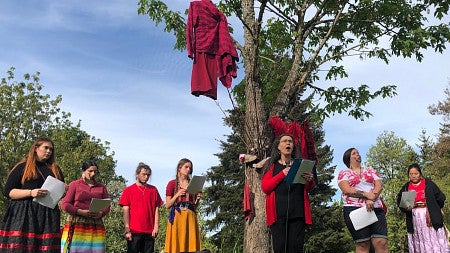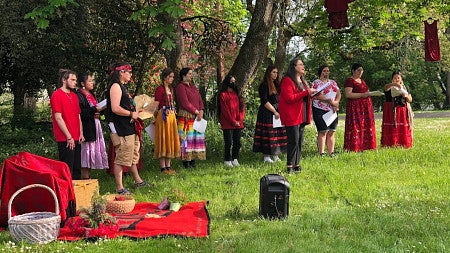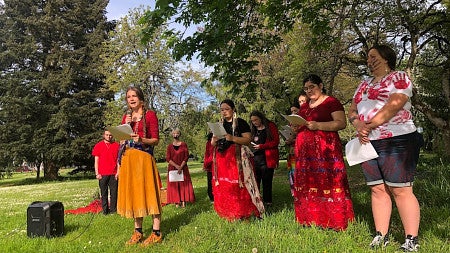Clark Honors College Theater Professor Theresa May and Elder-in-Residence Marta Lu Clifford speak on the power of American theater and performance to affirm and illuminate Indigenous cultures. The class they co-teach centers on contemporary Native drama and the way it actively engages the work of decolonization by telling stories that center Indigenous lived experience and histories.

Since 2011, May and Clifford have collaborated to direct, write and teach about tribal perspectives through theater. Clifford is a Grande Ronde elder with Chinook and Cree heritage and May is an ally of White Settler descent. Their course is one of the few that explores the specific field of Native theater and how it intervenes to assert Indigenous cultural sovereignty, celebrate traditions and languages, tell untold histories, and redress institutional settler colonialism in a vision of Native futures. In the spring of 2021, May was awarded the Thomas F. Herman Faculty Achievement Award for excellence in teaching and significant contributions to student learning. Both women are active advocates for the way theater can “spin new worlds into being” as one of their favorite authors, Monique Mojica, says.

Can you share about your backgrounds and/or personal connections to Native theater? What first drew you to this field?
MC: Well, I started with Native Theater in 2011, when I was asked to perform in the play that Theresa had written with the Klamath watershed called ‘Salmon is Everything.’ And truthfully, until then, I wasn't really aware that there was theater for Native people. And when I found out, I was very excited, and that was one of the reasons that I made myself available to take part in that production. And since 2011, I have been totally immersed in Native theater, everything from first taking Theresa's class as a student, and then becoming the Elder-in-Residence in the class. What drew me to the field was the fact that it gives Indigenous people a chance to tell their own story by writing plays, and then performing them for larger audiences. We need to get our stories out there, so more people can hear them. Native theater gives us an artistic voice that is alive. It’s different from reading a story in a book; telling our stories on stage has an impact on a lot of people.
TM: The trajectory of my entire professional life has been driven by trying to do work–make theater, teach classes – as an allied artist of Anglo-settler descent that redresses, perhaps helps heal, the damage of ongoing settler colonialism. It’s trying to do work that moves the dial forward in terms of social justice and environmental justice. As a theater artist, how do we use this art form to expand awareness, not only in terms of equity and diversity, but the actual history of the land that we live on? Right we are on Kalapuya Ilihi, the traditional homelands of the Kalapuya people who were forcibly removed by the United States government between 1851 and 1855. Once you know that fact, how do you move forward in your life? How does that knowledge change how you live, your artistic work or scholarship? We ask our students, what will change going forward, knowing the history that you were never taught? I became interested and passionate about making sure that we ask that question in the context of the art of theater, because theater has been both complicit in the mechanisms of settler colonialism, but it can also participate in repair by amplifying the voices of Indigenous people and others.

Can you tell me how long have you taught at UO, and how you both got involved with the CHC?
MC: I think I've been teaching with Theresa in her classes since 2012. It's been a long struggle to find a place for me at the University of Oregon. Things are changing. I'm not a professor, and never pretend to be. I'm an Elder. My title of Elder-in-Residence means that I'm there as a person with lived knowledge to help the students, to provide context and first hand reflections on what they are reading and learning. I'm involved with Clark Honors College because Theresa is!
TM: This is the first time I've taught for the Honors College. But I've been teaching at the university since the fall of 2006. And during that time, I've taught both performance-based courses acting, movement, theater for social change, as well as Native theater and Latinx theater.
I also teach a course about new climate change theater and other topics having to do with how theater can make a positive difference. What we're doing is, as far as we know, unique in the U.S. or was when we began. I have Native theater colleagues at other institutions who told me they have never taught a discrete class in Native theater, nor in partnership with an Elder from a local tribal community. So I am very lucky and what Marta and I are doing is unique. I think Marta and I both agree, we're thrilled to be teaching for Honors College. We love the eagerness of students, their willingness to blow their own minds and recalibrate who they are in the world. And they are asking themselves that difficult question of ‘now that I know this history, how is my life different going forward?’
Please describe the history and significance of the annual REDress poetry event in Springfield, honoring missing and murdered Indigenous women across our nation. Why was it important for you to produce the event?
MC: May fifth is the day of remembrance for Missing and Murdered Indigenous Women because it’s the birthday of one of the girls that went missing. Her mother tried to get help to find her and faced the jurisdictional issues that prevent these women from being found, or the crimes from being prosecuted. The crime happened on a reservation, and because the regular police don’t have jurisdiction there, the mother did all the searching herself. This was at a time when the epidemic of violence against Native women here and in Canada was becoming more publicly known, Native women are 70% more likely to be sexual assaulted, and end up murdered and missing. So many Native women are still missing and their families will never find them. So May 5 is a time that we honor those women and we talk to them. We talk to them through the poems and we send our voices out into the world so that they can hear us, so they know how much we care about them. Red is the color that they can see from the spirit world. So if they are in the spirit world, they can see the garments hanging in the trees. It's very moving to see them, very powerful. When you look up after you've hung out these red garments, there's a breeze and the dresses start flowing and moving. It can be very hard, emotionally, for some of the students and for myself, to go through this ceremony. But I think it's also very healing for them, and for all of us.
TM: The REDress event was started by Métis artist Jamie Black in 2010 as a public art installation in response to the epidemic of violence against Native and First Nations women. Since then there have been installations across North America by hanging empty red dresses from beams and ceilings in office buildings and shopping malls, from light posts on streets. In 2019 Jamie Black’s REDress installation took place in the plaza surrounding the National Museum of the American Indian in Washington DC. One day Marta and I were going for a walk along the Willamette River and she said, ‘we should hang red dresses from these trees!” She had a vision of all the trees along the trail filled with red dresses. So last year we gathered poems by Native poets, and I wove them together into a script to be spoken aloud by a group of women. Native students from the University of Oregon, and also faculty and staff, participated in reading those poems while members of the wider Eugene/Springfield community listened. We will do itevery year going forward.
Can you give some insight into HC 444/HC 421H: Contemporary Native Theater: Spinning New Worlds, the course you are co-teaching this term?
MC: We always have to start this course with having the students understand where they are at: Kalapuya Ilihi, and Ilihi is a word from the Chinuk Wawa language. So we're on the land of the Kalapuya people, which is so important that everybody knows that. And then we go through the process of explaining to them the many, many tribes that were all over the state of Oregon, and how now we have been reduced down to 10 Federally Recognized Tribes within the state, and they do a little bit of research about those tribes. For example, the Kalapuya are often part of the Confederated Tribes of Siletz Indians, or the Confederated Tribes of Grand Ronde in which I am enrolled. We have to start out by doing some history of the Indigenous people of Oregon so the students understand that Native people are not ‘things”--as some people have called them--of the past, but that we are very much still here in the present.
TM: Our class, “Native Theater: Spinning Possible Worlds into Being’ is taken from a quote by Monique Mojica, a First Nations playwright from Canada whose work we read. Part of what I think she means is that these plays, and their enactment on stage, provide a vision of a possible world going forward. One of the most important things about Native theater is that even when the plays tell stories of a history that includes trauma, every play is also a vision of the future; each play carries out the work of resilience, reclaiming, restoration, healing, affirmation of sovereignty. In the class we read stage plays written by Indigenous dramatists, and we read secondary critical articles by Indigenous scholars that illuminate how those plays function as activism and as interventions. Our hope is that students leave class able to share what they have learned and how they have changed with others in the course of their daily lives and careers.
Story by Kayla Nguyen, CHC Communications
Photos by Brian Bull
